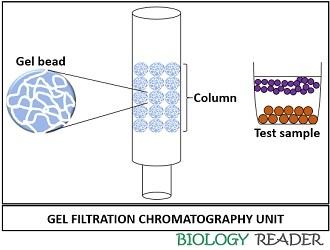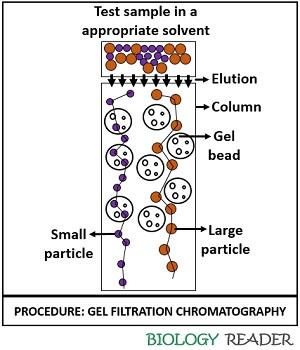Gel filtration chromatography is one of the chromatography methods that facilitate particles separation based on molecular size. Size exclusion, molecular sieve and gel permeation chromatography are the alternative names of gel filtration chromatography. The porous gel matrix is the stationary phase that contains a hydrated, sponge-like material.
Oppositely, the buffer solution or aqueous phase functions as the mobile phase, containing molecules of different sizes. The gel beads possess specific porosity due to which components with varying sizes may either retain or exclude through the column of the gel matrix.
Gel filtration chromatography is partition chromatography, where the molecules are partitioned between a mobile and stationary phase relative to their fractionation range. Resins or gel beads with a predefined size range refers to the fractionation range or exclusion limit.
The molecules larger than the fractionation range elute faster and enter the stationary phase quickly. Conversely, the molecules in the fractionation range move slowly. Thus, the gel filtration method plays a prominent role in the size analysis and determination of various biomolecules.
This post describes the definition, phases, principle and procedure of the size-exclusion chromatography. Besides that, the procedure, results, applications, advantages and limitations have been discussed in detail along with diagrams.
Content: Gel Filtration Chromatography
Definition of Gel Filtration Chromatography
Gel filtration chromatography refers to the chromatography method, which uses porous gel beads of specific porosity to isolate components depending upon their molecular sizes. This technique principally retains or excludes particles based on the size differences, hydrophobicity and molecular charges. It mainly helps in isolating biomolecules like proteins, peptides and oligonucleotides.
Size exclusion chromatography uses a porous polymer gel matrix that is embedded in a chromatographic column. Once the aqueous buffer is passed through the column, the liquid entered the pores of the gel matrix serves as the stationary phase, and the liquid outside serves as the mobile phase.
Phases in Gel Filtration Chromatography
- Mobile phase: The solvent running through the column is the mobile phase. Firstly, one needs to dilute the test sample in appropriate organic solvents. Then, filter and pass the test sample through the column. The separation of a multi-component mixture takes place in the column.
- Stationary phase: The column packed with microporous gel beads acts as the stationary phase. Hydroxypropylated Sephadex, cross-linked polyacrylamide, agarose gel are the common support materials employed in gel filtration chromatography.
Principle
The principle of size exclusion chromatography depends on the isolation of biomolecules relative to their different molecular weight or size differences. The gel filtration technique employs spherical gel beads with definite porosity as the packing material in the chromatography column.
The components in a liquid mixture pass through a column of porous gel beads, where some molecules elute earlier or later through the column, depending on the elution limit. The elution limit is a factor that decides the retention or exclusion of molecules through the packing material.

Molecules that possess high molecular weight compared to the elution limit will elute early. In contrast, the molecules with low molecular weight or size than the elution limit will elute later. In this way, the particles are separated in the gel filtration chromatography.
Procedure
The process of gel filtration chromatography involves the following sequential steps:

- Firstly, a column of spherical gel beads is prepared for the gel filtration chromatography.
- The packed bed is equilibrated with a buffer.
- Then, the test solution (mobile phase) is eluted through the column.
- After that, the particles in the test sample will enter into or diffuse out of the porous gel matrix (stationary phase).
- The molecules with a small molecular size will enter the gel pores, i.e. small molecules will cover a longer path or stay longer on the column.
- Large molecules with large molecular sizes cannot get into the pores of gel beads or easily pass through the column.
- Thus, the separation of the particles occurs at different intervals by following isolation and identification of the components separated.
- Fractionation and desalting are the methods that facilitate the separation of components in size exclusion chromatography.
- Desalting elutes the heavy molecules by keeping the exclusion limit of the gel smaller. The smaller molecules enter the gel pores while the larger particles leave the column.
- Fractionation isolates the target molecules within the gel matrix, whose molecular size must be within the gel’s fractionation range.
Results
The isolation of molecules from the gel filtration chromatography unit depends on the size distribution of microporous gel. It helps to construct a calibration curve that determines the molecular weight of an unknown analyte in the sample by comparing the molecular weight of known analytes.
Applications
- Gel permeation chromatography is a robust method for purifying biomolecules like enzymes, polysaccharides, nucleic acids, proteins etc.
- A gel filtration unit enables the renaturation of denatured proteins.
- It aids in protein fractionation experiments.
- One could examine the molecular weight of the separated particles by employing gel filtration chromatography.
- It is a method that also examines the quaternary structure of purified proteins.
Advantages
- Gel filtration can separate biomolecules sensitive to varying pH, temperature, the concentration of metal ions etc.
- The particles do not stick to the chromatography medium, like in the ion-exchange chromatography.
- It takes minimal time to explicate the result.
- It gives a well-defined separation.
- A small amount of test sample is enough to conclude the results.
- One could set the flow rate.
Limitations
- To prevent particles from clogging within the instrument, one needs to filter the test sample before passing it through the gel filtration column.
- Any dust or particulate matter within the instrument may interfere with the result interpretation or give aberrant results.
Conclusion
Therefore, gel filtration chromatography is a technique that depends upon the molecular weight of the biomolecule, size distribution of gel beads and elution limit. The movement of small molecules is slower than the large molecules due to rapid diffusion into the pores. Oppositely, the larger particles cannot move into the pores, move more quickly and leave the column rapidly.
Thank you for the post about Gel Filtration Chromatography. You made it really easy for me to understand. Without your help, I may have never understood this so easily.